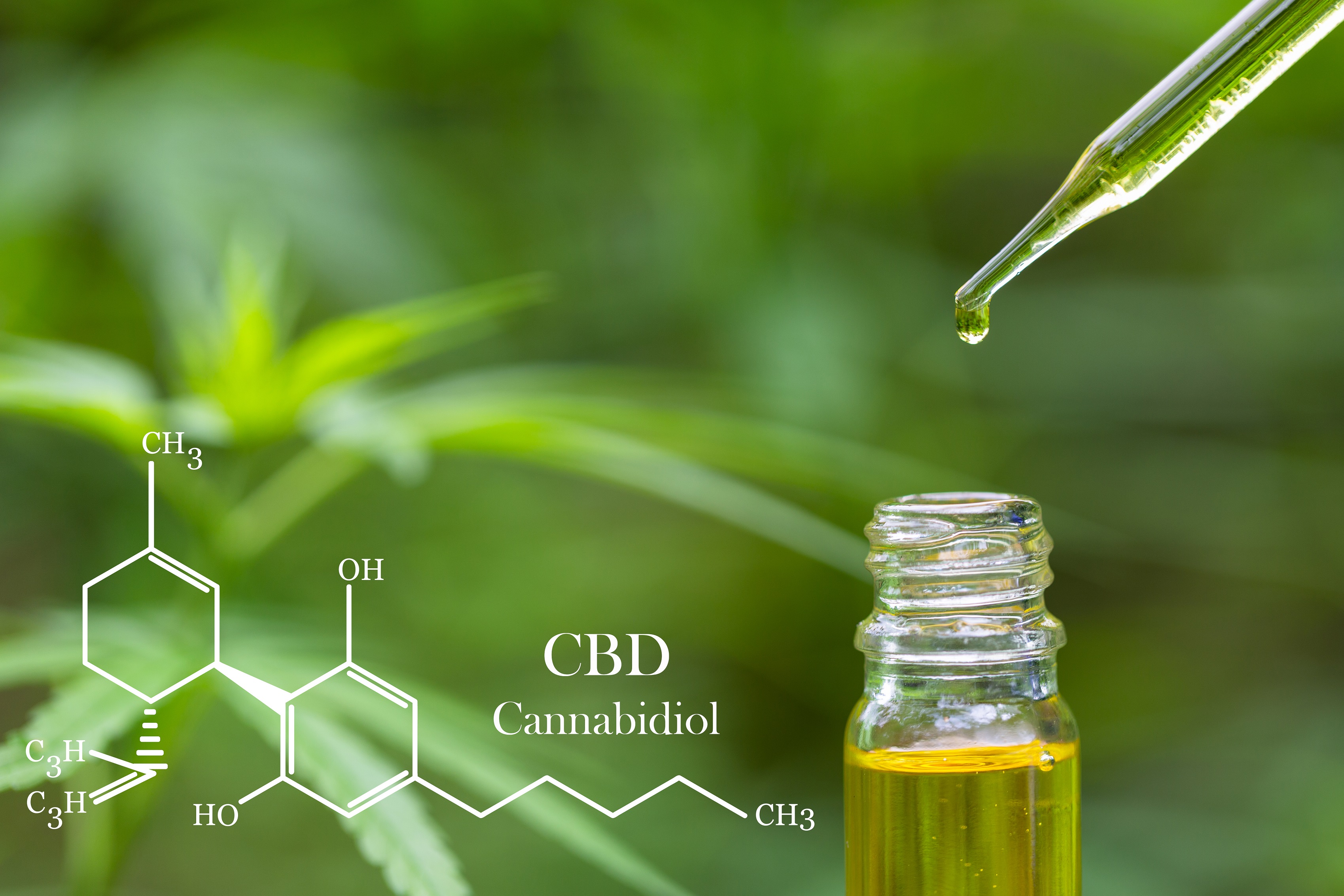SPONSOR: Applied Biosciences Corp. is a vertically integrated
company focused on the development of science-driven cannabinoid
therapeutics and biopharmaceuticals, as well as state-of-the-art
testing and analytics. As a leading company in the CBD, Pet and
Health and Wellness space, the company is currently shipping to the
majority of US states as well as to 5 International countries. Click Here for More Info
For how quickly the world fell in love with CBD, it seemed like we automatically made it okay for our dogs to take it too.
Perhaps one of the first instances where a new medical craze was
brought along to our furry friends as well, there’s been a growing trend
of people giving their dogs CBD Oil for an array of issues including
everything from socializing problems to digestive issues. Yes, for as
much as we hear about CBD being a miracle drug for humans, we have heard
just as much about it being amazing for our dogs as well. Granted, we
understand the skepticism (which we’ve felt too), which is why we wanted
to learn more too.
Although we’re still in the infancy of studying CBD, early signs have
pointed that it’s not only great for humans but other animals with an
endocannabinoid (the receptors of CBD) too, (including man’s best
friend). And if you’ve been considering taking the leap to give your dog
CBD oil soon, then there are a few things you should consider
beforehand. Luckily for you, we’ve put together the lowdown on what you
need to know about your dog taking CBD and how to get them into it
proper. Check it out below:
The Best Products
I’ve compiled the best CBD dog products here.
It’s important you pick products that are not only healthy for your dog
but also taste good. If you can get your pup on the habit of taking CBD
consistently, the products on the list above should be able to help a
variety of ailments including anxiety, crate training, new environment,
arthritis, natural aging, and agitation.
The Big Boom
The passing of the 2018 Farm Bill, industrial hemp became federally
legal for the first time since the early 1900s. This legalized a large
portion of the CBD industry nationally, primarily the plants that don’t
contain THC (the psychoactive ingredient in marijuana) which usually is
derived from female plants (which contain THC and CBD). Instead,
industrial hemp is primarily grown as male plants, which only contains
CBD, and thus, giving us an entirely new industry all across the United
States that’s estimated to hit $22 billion
by 2022, according to Rolling Stone. Yes, we’re entering a new ‘Green
Rush’, one where a lot of entrepreneurs across the spectrum (including
in the pet industry) have wanted to get their hands on.
Despite CBD still being in its early stages, the lineup of products
we’ve seen has had a serious boom over the years. According to Consumer
Reports, an estimated 64 million people
have tried CBD, which is anticipated to rise even further as
word-of-mouth over the products spread. Furthermore, the plant isn’t
just used by young people, with Baby Boomers becoming one of the
fastest-growing segments of users out, increasing at 25 percent
over the past year alone, as noted by AARP. And for something to spread
so quickly, we have to pause and ask: what value do people (let alone
our pets) take from this?
What Do We Use CBD For?
Perhaps the most complicated aspect of learning about CBD is understanding why exactly people take it.
If you were to ask any current CBD user the exact question of “what do
you use CBD for?â€, you’ll be given a different each time, with some
people reporting that it heals everything from aches and pain to others
stating it alleviates anxiety. While a lot of these reports have been
unproven, there’s been not only a strong word-of-mouth presence in
support that has a solid amount of action to stand behind it; in fact,
in 2017, we reported that nearly half
of people who use CBD stopped taking traditional medicine. Phenomenons
like that don’t happen often, which begs the question: Does this really
work?
Granted, the effectiveness of CBD depends on quite a few factors,
including the source, strength, medium of ingestion, or even if it’s
really CBD (according to a 2017 survey by U Penn, over 70 percent
of CBD sold online was mislabeled). While the industry has made strides
since federal legalization, there’s also a fair amount of bad actors
who are out to sell whatever they can. However, this is why before you
buy for yourself (or your pets) there are a few things you should
consider about sourcing.
With CBD, there are a few different extraction processes, which are
commonly referred to as CBD isolate (no THC), broad-spectrum (might
contain THC), and full-spectrum (contains all aspects of the plant,
including THC). The majority of products you’ll see in states where
recreational and medical marijuana are illegal will contain isolate, as
it has the least amount of THC in it, however, that’s not to say there
aren’t evangelists for broad or full spectrum.
A big reason that people are more into broad or full spectrums is
they argue that the effects are better. Additionally, as it goes with
many other health crazes, a lot of the CBD industry tries to keep as
much of the product as natural as possible, which is why so many focus
on having vegan or organic lines. While it’s heavily contested and
disputed, the juries still out on how exactly the strength compares in
each spectrum. This is why it’s an interesting time to look into not
only the different uses of CBD but which patients find their version of
the medicine effective.
The most common reasons people take CBD include pain relief,
anxiety (which includes PTSD, general anxiety, stress, depression, and
social anxiety), epilepsy, and now with legalization, other uses like
athletic performance enhancement/recovery have sprung up as well.
Finally, CBD is often labeled as a ‘miracle drug’ because it
naturally fits with our Human Endocannabinoid System, which UCLA
Health’s Cannabis Lab refers
to as “arguably one of the most widespread and versatile signaling
molecules known to man.†This is essentially how our body takes in CBD,
which is why so many people have found different uses for its
effectiveness. However, that still doesn’t answer why did we start
giving it to our dogs.
Why We Started Giving CBD Oil To Our Dogs
The odd thing about giving CBD to our pets is that it’s probably one
of the only substances we started taking and immediately found it okay
for animals to do as well. Part of the reason we found acceptance so
quickly is that not only is CBD natural, but natural for dogs to take as
well; in fact, as noted
by Canine Journal, both humans and dogs have an endocannabinoid
system…the same as we mentioned above for ourselves. And for that, we
started experimenting with how CBD could possibly help our furry friends
with the same issues we face too.
The popularity of CBD for dogs started out because there was a
genuine belief that what it did for us could also be done for dogs. In
many ways, the same social phenomenon we saw in humans started to
reflect in pet owners as well, with claims that it helped older dogs
with joints pains to skittish dogs with anxiety from fireworks. Although
the research is still in its infancy, this has blown up as an industry,
which CNBC notes that research estimates for pet CBD alone could be
worth $1.16 billion by 2022. Despite its popularity though, we’re still working through how exactly CBD works for our pooches.
While there have been some studies conducted, the overarching
research is limited. In light of these setbacks, early quantitative
research that examines the effects of CBD on dogs has been promising.
Especially as many of these use cases are the same we’ve found in
humans, the parallels have been outstanding, and provide promise into
what the future could hold between our dog’s relationship with CBD as
well as how it correlates with our own. Here are a few of the categories
on what we’ve found:
Pain Management
One of the first early uses of CBD for dogs has been pain management.
While we often hear about older pet owners using CBD for their dog’s
joint pains, the usage has become much more extensive than that, with
research to back it up as well. According to a study
by Cornell University published by the Frontiers in Veterinary Science,
CBD was shown to be helpful in a sample size of older dogs with
arthritis pain. We’ll note that the study, while conducted properly,
still showcases a good point in how we look at researching subjects like
pain management and CBD for dogs: it’s hard to gauge just how effective
the management actually is.
As we’ve already seen different CBD companies offering dog treats in
different dosages, the general assumption is that the owners are giving
these recommended amounts based upon the dog’s weight and size. While
that’s the conservative norm, there already have been early cases of
owners giving their dog too much CBD, which can pose greater health
risks within itself. Yet, it’s difficult for us to understand how much
pain our dog might be in beyond them outright screaming, which is why
it’s best to bring your dog to the vet if you feel as though they might
be experiencing any aches or pains before administering them CBD.
When talking with your vet, it’s important to get a good gauge on how
much pain your dog might be in, as well as what dosage of CBD might be
right for them. Although there’s a grey area in regards to veterinarians
actually giving CBD as a recommendation, a lot of them agree that
they’ve had patients who’ve claimed that it can help. The most common
use that’s been seen is recurring aches (particularly, joint pains in
taller or bigger dogs), which often come with old age regardless. Even
still, talking with your vet will help in understanding if CBD is right
for your pooch, as well as what type of CBD product might be best for
them (such as infusions with fish oil or Omega-3s for inflammation).
Seizures
As we’ve seen CBD being used for human seizures and epilepsy, the
treatment might remarkably be the same for pets as well. The American
Kennell Club is noted
for trying to test this theory, particularly in early clinical trials
that involve 12-week sprints of using CBD versus a placebo. Although the
research is still early, this could become a pretty interesting
development, because while canine epilepsy only impacts less than 1 percent
of dogs, it opens the door to exploring just how CBD can be used in
impacting common ailments between our pets and ourselves as well.
Gastrointestinal Issues
As noted
by Lola Hemp, one area of high ECS (endocannabinoid systems) is in the
gut, which is why many pet owners have noted CBD to be helpful in easing
gut health. The particular places it’s been helpful have included
digestion problems such as IBS (irritable bowel syndrome), constipation,
acid reflux, and nausea. Furthermore, CBD has also been helpful in
easing food allergies or gluten sensitivity. Although still an early
candidate, early studies have suggested that CBD can help quite a bit in
our dog’s digestive health (as well as with humans too!).
Anxiety
Anxiety is always most visible in dogs, with many dealing with
certain instances of anxiousness (such as separation anxiety) or holding
onto a specific learned behavior from their past (such as lashing out
at someone that resembles an abuser). What makes a dog’s anxiety so
difficult to deal with is the frequency and severity of it; for example,
a dog that might get scared of fireworks on the 4th of July may or may
not need CBD,
while trying to treat separation anxiety with only CBD might be more of
a challenge. For this reason, it’s important to take a step back and
look at what exactly it means to be responsible administrators of CBD
for anxiety in our pets.
One of the dangers people face when treating their dog’s anxiety with
CBD is becoming reliant on it as a crutch. Quite simply, there are
certain behaviors we need to train out of our dogs, such as learning how
to stay calm when we’re not home or not lunging at other dogs or
people. This can be a challenge communication-wise because once a dog
has been administered the CBD, it’s hard to get a gauge on when it weens
off. However, that’s why (like with pain management), it’s best to consult with an expert to truly get a diagnosis and action plan.
When speaking with your vet, be mindful that the focal point of your
conversation shouldn’t be “should I give my dog CBD?†but rather “what’s
the best plan for alleviating my dog’s anxiety, and how can CBD
possibly help?†Ultimately, your vet will probably want to go over what
your dog has been doing, any behavioral things you can begin teaching in
your day-to-day, and how you plan on implementing CBD into this
routine. Try to establish checkpoints of how your dog’s treatment has
been going, as well as how you can start weening them off of their
dosage or CBD entirely. Remember, this is a catalyst to helping your dog
into a better life, not the end solution.
As one of the most exciting developments in CBD for dogs, treating
anxiety with it could be an absolute gamechanger. An incredibly popular
option amongst pet owners, it’s going to be interesting to see how the
market develops, particularly in what products might be infused with CBD
to further help pets in other things going on as well. However, even
with all the hype, the traditional veterinary world still has its
concerns, which has opened a whole can of worms over what comes next.
How Has The Veterinary World Responded?
While the veterinary industry isn’t exactly against CBD, there’s
still some concern in regards to coming up with a consensus opinion. As noted
by CNBC, neither the FDA nor the American Veterinary Medical
Association has yet to make a public statement in support or against our
pets taking CBD, which makes sense given how the industry is still
by-and-large at its foundation. However, that’s not to say there aren’t
certain overall concerns that those working in the field haven’t brought
up.
Perhaps the biggest criticism of CBD for our pets that come from vets
is simply not employing what they were educated to do…and rightfully
so. Diagnosing what could potentially be wrong with a dog is not up to
the owner, but a medical professional, and regardless of how natural or
harmless some people believe CBD can be, it doesn’t negate the fact that
it’s still a substance being given to an animal that has an elementary
level of communication with us. Furthermore, vets (as well as
researchers) are still trying to figure out how CBD reacts with certain
breeds of dogs over others, which can play a pretty pivotal role in how
it gets diagnosed and in what dosages. However, despite these
limitations, many vets are still giving CBD the green light.
Even with the limited knowledgebase behind diagnosing CBD relative to
the rest of the veterinary field, many vets are still working with
owners if they want to give their pet a shot with the substance. The
primary reasoning behind this goes back to the inherent design of CBD in
our pet’s bodies, which is that it’s reactive with our endocannabinoid
systems, defining it as a natural remedy. Furthermore, most vets agree
that as long as a patient isn’t self-diagnosing or consulting an amateur
on how much CBD their dog should take, then it’s a relatively harmless
substance to ingest. However, the dangers behind it have started to rise
up with increased usage, which has been the cause of some concern
between vets, owners, and the dog community as a whole.
The Dangers of Dogs Using CBD Oils
Although there’s yet to be a reported overdose of a dog on CBD, there
certainly have been plenty of cases of poisoning. According to the
ASPCA’s Poison Control Center, there’s been a 700 percent increase
in marijuana-related pet poisonings in 2019 alone, which is a grave
cause for concern amongst owners. While it’s true that every new
substance like CBD is going to have those who overdo things, this is
still a widely unregulated industry, which comes with the territory.
Beyond just consulting with your vet over if CBD is right for your
dog and how much they should take, the other half of the equation is
what products they should be taking. The industry hosts a lot of bunk
items, which while most will be harmless to your dog, others can be made
with filler or junk, which can cause trouble in itself. Furthermore,
while mixing an oil or tincture into your dog’s food might be fine,
going overboard on certain CBD treats can not only cause tummy aches but
lead to real issues as well. And finally, don’t forget that in states
where marijuana is recreationally legal, some treats that are designed
to be CBD treats for dogs can contain slight to moderate amounts of THC
in them, which your dog might have a terrible reaction to.
Ultimately, talking with your vet will help in preventing the most
common issues that could occur with your dog, which is why we stress it
as a first solution. However, if you do find yourself where an accident
may have occurred, the ASCPA lists the following as common symptoms of CBD/THC pet overdose:
- Lethargy
- Ataxia
- Urinary incontinence
- Vomiting
- Hyperesthesia
- Some pets with larger exposures have even become recumbent
Granted, as most dog owners will tell you, there could be any number
of reasons that these symptoms are occurring. The difficult part here is
determining if it was the CBD that caused or not, as well as how
heightened your emergency might be. A good rule of thumb with our pets
is that it’s better to be safe than sorry, so even if it turns out your
dog was coincidentally throwing up from eating too much grass, having
that assurance over knowing it was because of a new CBD regiment could
literally be a lifesaver. Finally, if you feel as though your dog had
CBD that was either a bad batch or poisoned, contact the ASPCA’s Poison
Control Center ASAP at the number listed at the bottom of this article.
Final Thoughts
Perhaps the most impressive aspect of the CBD dog industry is that
it’s still very much in its infancy. In a lot of ways, this is the most
exciting time to be involved, getting in and learning about the
potential of how we can improve the lives and health of our furry
friends. On a much larger level, however, there are still some concerns
over how this industry will develop, as well as to what regulatory
bodies will oversee the production of CBD for dogs and the types of
ingredients being allowed. Remember, even though most of what we’re
making can be consumed by humans too, we still don’t know small things
such as how CBD might interact with other substances once ingested by a
dog, and for that, we’re still very much experimenting.
The biggest issue with this ‘experimental’ phase is oversight over
scalability, which could become dangerous if regulators don’t act
quickly. According to Bloomberg, in 2019 alone it’s estimated that
approximately 10 percent
of the CBD market will go towards pets, making them a primary consumer
more so than in any other natural remedy or industry. As one of the
first times that we’ve had a substance we can share with our pets, this
is an exciting time, but also one with its hesitations over what they
can and can’t ingest.
One of the first things we should consider with implementing
regulation on CBD dog oils, tinctures, and treats is what substance that
can and can’t be used in combination with the CBD. Even those who are
making CBD oils for humans that they advertise as safe for dogs needs to
be thoroughly checked that a dog can have some as well. Additionally,
improving labeling on the packaging, including what ingredients are in
there as well as the potential side effects for our pets is an absolute
must, as well as looking into how different combinations of foods or
other substances that might affect the dog too. While we already have a
relatively good grasp on what dogs can and can’t have, this is still a
subject we’re learning about, and when it comes to innovation, sometimes
new things can have unfortunate consequences.
All-in-all, it’s an exciting time to be in the CBD industry
(especially for our furry friends). While there are some roadblocks and
setbacks ahead regarding an ironclad set of what they can and can’t
have, the future is looking good. A big part of this will be how we can
continue to create new and great solutions for our dogs, which could
even improve certain everyday functions with them as well, such as
easing them on car trips or helping them gain their appetite back. If
done right, CBD could establish a foundation for dogs to live the best
we’ve ever seen them, which is a remarkable feat in its own right.
Tips For Easing Your Dog Into CBD
Consult Your Vet
As we stated above, your vet is going to know best, which is why you
should talk to them first about if CBD is right for your dog. Make sure
to be forthright and honest with everything you know, as well as walk
out of the office (or call) knowing the exact amount of CBD you should
be giving your dog per their weight and diet restrictions, as well as if
there are any red flags you should look out for. Even though this is a
new medicine, your veterinarian knows much, much more than you do about
your dog (no offense) which is why they should always be your first
go-to with any new substance.
Know Why Your Dog Needs It
While administering CBD has been a growing trend for dog owners, that
doesn’t necessarily mean your pet needs it. Despite its wonders in
curing things like anxiety or appetite, these can sometimes be symptoms
of bigger problems that CBD alone can’t solve. Ultimately, CBD can
either play a great catalyst in helping get over existing problems, or
in helping to cope with life-long ones. Remember, this is a medicine,
which while humans might take it recreationally or for problems like
social anxiety, that doesn’t mean your dog needs to be like you. Quite
simply, sometimes man’s best friend is just fine how they are.
Have An Action Plan For How They’re Taking It
Even if your dog does need CBD, that doesn’t necessarily mean they’re
going to like it. To combat this, a helpful tip is putting your dog’s
CBD oil in their food or inside a treat like a scoop of peanut butter.
Certain companies have started to develop CBD dog treats, which have
been a great alternative to trying to squeeze tinctures in their mouths.
Ultimately, you know your dogs taste best, so pick which method you
think they’ll love the most and ease them into things gradually and
slowly.
The other half of your action plan needs to understand when and why
they’re taking CBD. Even though you might have CBD in your possession
doesn’t mean it’s the appropriate time or emergency for your dog to be
taking it. Consult with your vet what symptoms you see that require them
to take CBD, as well as the proper way to dose them on it.
Know What To Do In An Emergency
As all of us would be heartbroken if something happened to our pet,
it’s imperative you have a backup plan in case your dog has a bad
reaction to CBD. Write down the ASPCA’s Poison Control Center’s number
at 1-888-426-4435 and place it on your fridge or store it in your phone.
Trust us, it might be a lifesaver.
Keep Your Behavior Consistent
With your dog getting used to CBD, it’s important you keep your
relationship and routine the same with them. For example, if you’re
giving your dog CBD for social anxiety, then going about socializing
with them normally will help in the process when you eventually ween
them off. In short, this isn’t a time to give your dog CBD and let them
be, but rather embrace this an opportunity to get to know them better,
as well as grow your relationship further.
Souce https://www.forbes.com/sites/joresablount/2019/10/01/cbd-oil-for-dogs-everything-you-need-to-know/#601a35d67c9e:












